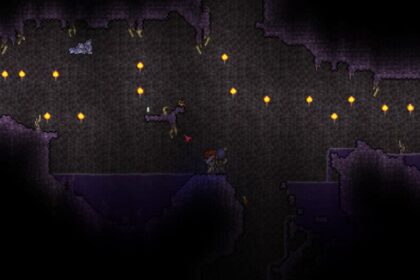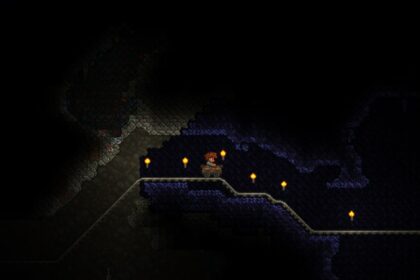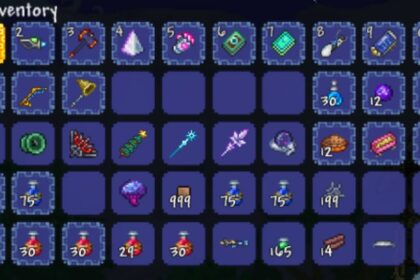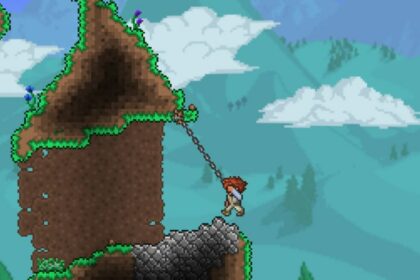There are a few types of buckets, each with its own purpose. Understanding how to make a bucket in Terraria is the first step to being able to use buckets to their fullest.
While buckets may seem simple at surface level, there is a lot more to using buckets than meets the eye. They have many different functions, ranging from healing to traps. Therefore, ultimately, they will become an integral part of your Terraria playthrough.
Additionally, buckets appear in many crafting recipes. This guide will walk you through how to make a bucket in Terraria, the different types of buckets, and their uses.
Bucket
The Empty Bucket is the standard type of bucket in Terraria. As the name suggests, it has no liquid in it – it’s empty.
Empty Buckets can act as a helmet but grant a measly 1 defense. This means that the primary use of an Empty Bucket is scooping up liquids to create other types of buckets.
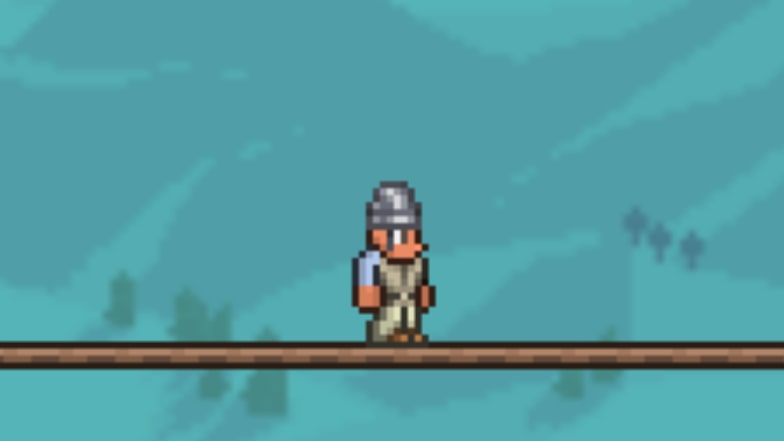
Like crafting chains, you will need Iron/Lead bars to craft an Empty Bucket – 3 in total are required. It can be crafted at an Iron/Lead Anvil.
Iron and Lead will appear in veins throughout the surface, underground, and cavern layers of your world. Each world is restricted to having either Iron or Lead – not both. Whether you have Iron or Lead is determined at world generation, with a 50% chance for each.
You can also obtain these ores from all types of crates and, occasionally, as a drop from Slimes, but farming Iron/Lead these ways is much less inefficient than going mining for them.
Water Bucket
Left-clicking on any body of water will collect one tile of it, creating a Water Bucket. Upon placing the water from the Water Bucket, said bucket will turn back into an Empty Bucket and can be reused to collect any body of liquid.
Water Buckets have several uses in Terraria. Firstly, fall damage is negated if falling into water. This means that by using Water Buckets to place water where you please, you can diminish the concern of dying in particular areas.
While this isn’t particularly helpful in the late game, it can be a lifesaver in the early game. Also, the ease of access to Iron and Lead from early in the game means that Water Buckets are a very accessible, easy way to stop fall damage.
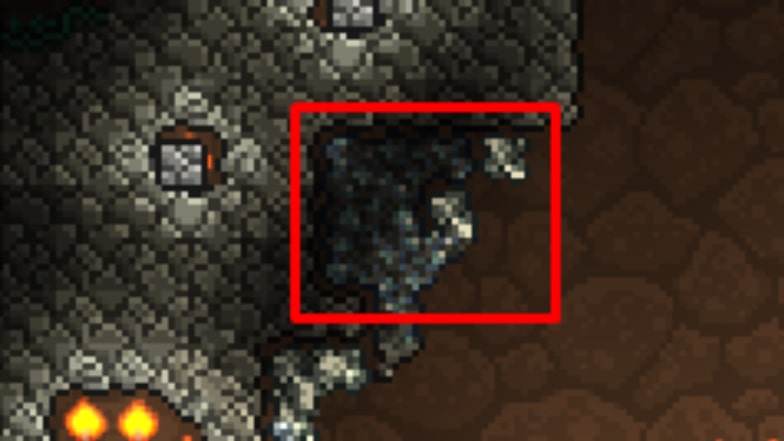
Another use for the Water Bucket is creating fishing biomes. Knowing how many blocks for a biome can be tough; however, the amount of liquid tiles is always the same. To create a fishing biome, at least 75 connected tiles of liquid are required.
The only exception to this is creating an Ocean biome – which requires 1000 connected tiles of water.
Despite fish being found in both water and lava pools, the majority of them are found in water. Therefore, Water Buckets are essential for creating fishing biomes and obtaining most fish with ease.
Additionally, water acts as a minor crafting station. Therefore, by placing a Water Bucket, you’re also technically placing a crafting station. Items that can only be crafted at a body of water, or a sink, include Bottled Water and Mud blocks. Both are very important in crafting potions and creating biomes, respectively.
Bottomless Water Bucket
The Bottomless Water Bucket is identical in function to the standard Water Bucket; however, it cannot be emptied and, therefore, cannot be refilled. It’s usable an infinite number of times and can be placed slightly further and faster than a standard Water Bucket.
It isn’t a craftable item – instead, it can only be obtained from the Angler NPC by completing quests. It has a 1/70 (1.43%) chance of being a reward after the 10th quest; the Bottomless Water Bucket is a rare item.
Due to its infinite water placement ability, it can be instrumental in creating fishing biomes. With the standard Water Bucket, you’d have to keep emptying and refilling the bucket. However, with the Bottomless Water Bucket, this isn’t a problem.
Lava Bucket
Like Water Buckets, Lava Buckets can also be created by left-clicking with an Empty Bucket – only it’s with a body of lava rather than water. When the lava is placed, the Lava Bucket becomes an Empty Bucket again and can be refilled with any kind of liquid.
Because of their ability to damage enemies, Lava Buckets can be an integral part of some enemy traps. Making a lava trap is straightforward and can be great at protecting your NPC town from enemies – especially during events such as the Goblin Invasion. The lava trap is widely considered the most basic trap and is, therefore, great for the early game.
Simply dig a pit 10 tiles wide and 5 tiles deep. While there’s more flexibility on the width of the pit, the depth of the pit must be at least 5 tiles; otherwise, NPCs could walk into it and die of lava damage. Once you have dug your pit, place one lava bucket in it and wait for the lava to settle.
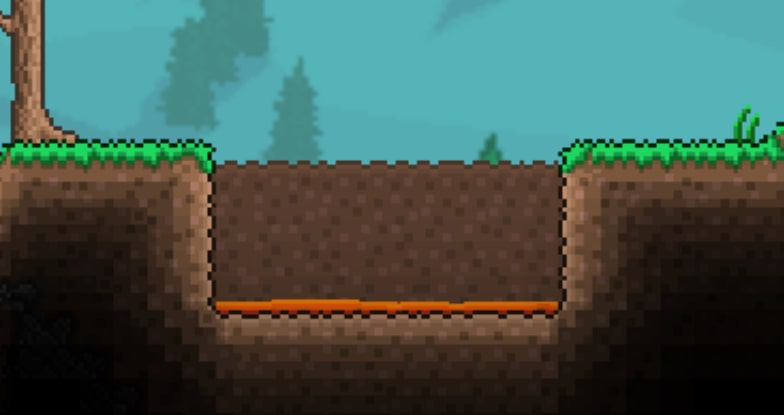
It’s important that you only use one lava bucket as this will prevent loot from being destroyed by the lava.
Bottomless Lava Bucket
The Bottomless Lava Bucket has the same functions as the Bottomless Water Bucket – except it places lava rather than water.
It can be beneficial for creating fishing biomes that require lava pools instead of bodies of water, as it won’t need refilling every time it’s emptied.
Unlike the Bottomless Water Bucket, the Bottomless Lava Bucket is not an item obtained from the Angler NPC as a quest reward. Instead, it is a rare drop from fishing in lava.
Honey Bucket
Honey is arguably the most challenging liquid to find in Terraria, as it resides in Beehives that are randomly found in the underground Jungle biome. To create a Honey Bucket, simply left-click a body of honey. It’s worth noting that, unlike Water and Lava Buckets, there’s no “bottomless” variant for honey.
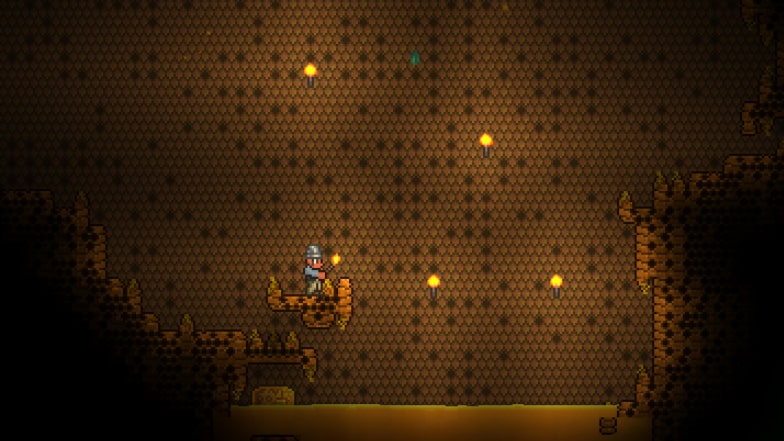
Honey flows more slowly than both water and lava and has a unique regenerative property called the “Honey” buff. This buff regenerates health at a rate of 1HP per second and increases the natural health regeneration rate by 3x. On top of this, it reduces the damage from tick-damage debuffs such as “Cursed Inferno” and “Venom” by 2HP per second.
These factors make honey ideal for boss fights, such as Skeletron and other situations where you may need additional health regeneration. A common way of ensuring you maximize the benefits of honey is by arranging balloon blocks in a square, with a one-tile space in the middle.
In this empty tile, you should place the Honey Bucket. The nature of balloons means that they won’t act as an obstruction; you can pass through them and gain the “Honey” buff.
Conclusion
Now you know how to make buckets and their uses, you’ll be able to fully utilize them in your Terraria world. It’s important to remember that they only require 3 Iron/Lead bars, meaning that they are available very early in the game.

